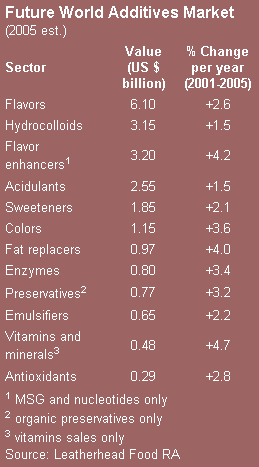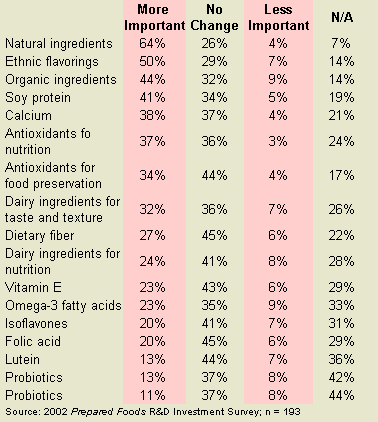
The food industry usually is not considered “high tech”; however, advances in analysis and the identification, separation and processing of new food ingredients provide a progressively broad set of “colors” from which product developers can choose.
For this article, we turned to a diverse group of experts whose careers are founded on understanding the technical, cultural and creative issues underlying ingredient choice and application. Their answers remind of us of how far ingredient technology has come, and also point the way to new products soon to be available to food formulators.
A special thank you goes to the panelists, all whom are in the midst of very busy careers. More information on them is provided at the end of this article.
PF: In what ingredient categories (or individual ingredients) have the most useful advances been made in recent years?
Mary Mulry (MM), Wild Oats Markets Inc.: The big areas have been soy ingredient flavor improvement and masking agents, omega-3 fatty acids (no more fish oil taste), physically modified corn and other starches, development of organic ingredients, such as organic gums, sucralose as a sweetener and the availability of lots of antioxidants—grape seed, green tea, blueberry, and so on. Also, the development of specialized ingredients such as CLA for lean muscle building and the rediscovery of the benefits of saturated vegetable fats, such as palm oil, coconut oil.J. Hugh McEvoy (Chef J), culinary consultant: In the area of bakery ingredients, advances in enzyme technologies have been amazing. Shelf-life, production yields and product quality have all been dramatically improved. And starch technology, in general, has come a very long way.
Paul Lachance (PL), Nutraceuticals Institute at Rutgers University: Nutritional ingredients have had a major impact on health. Food fortification, which provides as much as 25% of the required dietary amounts of vitamin B1, 2, 3 and now folate, has cured and/or prevented deficiency diseases. Now, prevention of chronic diseases and improved [life] performance are happening. Contrast that with the use of artificial sweeteners and fat mimetics, which have not slowed the increasing rate of obesity.
PF: Where do you expect the most significant advances to be made in the next five years?
MM:There will be continued development of specialty organic ingredients and more emphasis on real answers to weight loss, diabetes and syndrome X.PL: In next five years, we will begin to sort out which non-nutrient factors are critical for chronic health prevention such as omega-3s, lycopene, lutein and other nutraceuticals.
Leslie Skarra (LS), with significant input from her entire staff at Merlin Development, Inc.: There will be advances with fats and oils and with functional foods, particularly in terms of understanding their effects on the body.
Chef J: The Baby Boom is still the 600-lb. gorilla of customer preferences. We will see advances in health-related ingredients, targeted to the needs of the older customer. This will be driven by market demand.

PF: Where is the most research needed?
John Madden>/b>, Leatherhead Food International: The area of moisture management within foods, particularly composite foods, has received a lot of attention, but we are still a long way from doing what we would like to do. Moisture migration within foods still limits shelf-life, both from a quality and a microbiological standpoint. A greater understanding of such processes and how to control them is required. There are a number of moisture barriers on the market, but further advances in this area would provide many new opportunities.While obviously very active at the moment, there should be sustained research into proving the health promoting benefits of ingredients, i.e., clearly establishing the scientific evidence to back up any claims or any implied claims, particularly the effectiveness of such ingredients in processed foods at levels at which they would normally be consumed.
MM: Research to understand both synergists and antagonists to healthful ingredients is needed. The assumption is made that if a little bit is good, more is better. This may not be so.
PL: The most needed research is the discovery of compounds, delivered through food ingredients, which are capable of blocking the 8-9% of known genes causing breast/prostate cancer. There are possibly others. This will be done through metabolonics (the study of metabolic processes), along with nutragenomics.
LS: One need is in the area of commodity ingredients. When a short supply develops, the industry is often caught “flat-footed,” and there is an urgent rush to find replacements.
Another area also relates to “commodity” ingredients. Since they are low-cost, they occupy a large proportion of formulas. However, since they are low-cost, companies also cannot afford to do much research to optimize their properties to best suit processors. Flour is an excellent example. Much research is done to test better-yielding varieties. Comparatively less research is done to optimize varieties for performance in food products.
Amy Stockwell (AS), Analytech Associates: The most significant area for advancement and further research is in the area of carbohydrate metabolism. Just as lipid metabolism and chemistry dominated the thinking of both the medical and nutritional communities during the 1980s and 1990s, carbohydrate metabolism will be the key food area in the future. How does the glycemic response affect weight gain? What are successful weight loss strategies? How do simple sugars affect body chemistry? Can ingredients (such as soluble fibers), which affect the glycemic response, change either satiety or weight gain patterns? What role do carbohydrates (complex and simple) play in a healthy diet?
Chef J: Research also is needed into the “hedonistic” value of food ingredients. The meaning of “quality” and the meaning of “delicious” are not the same. In the past we have sometimes forgotten this simple fact, but our customers have not.
PF: Consumers are increasingly sophisticated about ingredients. How has this impacted the selection of ingredients with which product developers can work?
MM:Consumers want to know the origin of ingredients, and they prefer natural to synthetic. They also want to understand the specific health benefits. Consumers are looking for real science, not just hype.
Consumers also are beginning to understand that there may be specific requirements that apply to more limited groups, like those that are sodium sensitive, have cholesterol metabolism problems, allergies, or tendencies toward diabetes. These consumers will have deep interest in certain ingredients or food products that may not hold interest for the general population. Thus, to mine these opportunities, developers may end up targeting products or product lines to “micro markets.”
Chef J: Our customers are demanding a higher-level “eating experience,” not simply inexpensive and wholesome “fuel.” America is moving in the direction that Europe has already gone. Every customer is coming to expect every bite of food to be delicious, healthy, safe and a true value. Not cheap, but worth the price.
PF: Can you make predictions for ingredient use trends?
MM:There will be more fusion-type flavors, complex culinary combinations, polyphenolic and antioxidant ingredients, and more natural sources of healthful ingredients. These trends relate to increased food consciousness; more organics, more purity. Trans-fat producing ingredients will decrease dramatically.LS: The whole category of flavors that provide sensory “excitement,” without requiring fat or salt, will continue. Masking flavors will continue to have importance because functional ingredients often have poor taste characteristics that need to be covered. Unfortunately, most masking flavors have yet to deliver the promised functionality.
Chef J: Ingredients can be categorized as those that attempt to recreate flavors, aromas, visual appearance and textures of “gourmet” products. A second category of ingredients consists of those that help attach health benefits to common foods. These are pieces of the same puzzle. To truly succeed with a food product, we must put the whole puzzle together. Our customers are coming to demand it.
PF: Does it behoove ingredient companies to spend money on educating consumers?
MM:It is very expensive for ingredient companies to educate consumers directly. They should partner with branded retail product companies and retailers and work the media rather than doing direct advertising to consumers. Consumers need context to get messages—that comes from products, not ingredients.PL: Education at all levels is needed. Currently, only nutrient suppliers sponsor research and education. But IFIC does educate with support of a cross-section of food companies. Consumers are more sophisticated but are also quite divided on which of the issues are important. There is a great need for teaching risk assessment so perspective is less naive.
Chef J: Unless a company has the resources to impact “the world” in its educational efforts, spending money in this area will not yield returns. Special interest groups will be countering one type of “propaganda” with conflicting “educational” efforts. And the media tends to support the anti-food-business messages. It might be more effective to form an educational organization devoted to “truth in ingredient information.”
LS: Each time the food industry or the medical community rescinds a recommendation supported by early research, significant credibility is lost with the consuming public. While a clearly written campaign on the benefits of soy funded by the entire industry might help consumers to understand the issues and benefits of soy, the proliferation of brand names may just serve to confuse them.
Our distinguished panel (in alphabetical order):
Paul A. Lachance, Ph.D. F.A.C.N. is professor of food science and nutrition, Rutgers—The State University of New Jersey. Lachance is a past chair of the department and is currently the director of the Nutraceuticals Institute at Rutgers. lachance@aesop.rutgers.edu
J. Hugh McEvoy (Chef J), CEC, CRC, has developed products for companies such as Marriott Corporation, Starbucks, Ritz Carlton, Sky Chefs, Holiday Inn, Disney, McDonald's, Denny's, Arby's, Vie de France and Au Bon Pain. He received the Research Chef Association's 2002 President's Award for outstanding contributions to Culinology. file_01@hotmail.com
John Madden is head of Food Ingredients and Product Development, Leatherhead Food International, Surrey, U.K. With a background in ingredients research and R&D management in the frozen, chilled and ambient food sectors, Madden consults in ingredient applications and new product development. JMadden@LFRA.co.uk
Mary C. Mulry, Ph. D., is senior director of product development & standards, Wild Oats Markets Inc., Boulder, Col. She also has held product development positions at Kellogg Company, Kraft Foods Inc. and Celestial Seasonings. info@askfoodwise.com
Leslie Skarra, M.S., is principal of Merlin Development Inc., Plymouth, Minn., a contract food product development company specializing in new products in most application categories. Skarra previously held various product development positions at Pillsbury. lskarra@merlindev.com
Amy Stockwell, M.B.A., is principal with Analytech Associates, Decatur, Ill., an ingredients consulting firm. She previously held business development positions at A. E. Staley Manufacturing Company and Brown-Forman Corp. acstockwell@ameritech.net

Sidebar: The Industry's Take on Ingredients
Natural and organic ingredients continue to be important areas of expected growth, according to the Prepared Foods 14th Annual R&D Investment Survey. The R&D, marketing and general management participants in the survey indicated ingredients that they expected to become more or less important over the coming year, as well as those products that they believed had the greatest growth potential for their company. Ingredients regulated as “natural” made strong showings, with 63.6% of respondents indicating they would become more important in the next year, and 44.4% of survey participants indicating the same with organic ingredients. 54.3% of those surveyed listed “all natural/clean label” product with the anticipated highest growth for their organization.
Likewise, flavoring systems for ethnic products are expected to be pivotal in the upcoming 12 months, with 49.5% of respondents anticipating their increased importance. Ethnic foods for non-ethnic consumers appear to have increasing importance for respondents' companies, with 28.7% listing the category as that with the greatest growth potential.
Sidebar: Additive Insights
Leatherhead Food RA recently published a report that correlates trends and developments in the food additives market with trends in the processed food industry.In 2001, total world food additive sales are estimated to be about US $20 billion per year. The report notes a particularly growing demand for natural and organic ingredients, healthful ingredients for functional foods, ingredients that can enhance the shelf-life or convenience of a product, and ingredients that can add quality to mainstream foods.
Challenges facing suppliers include increased purchasing power of major multinational food groups, food groups showing greater interest in specialty and premium ingredients tailored for specific applications and strong competition from cheaper products manufactured in China.
These factors have resulted in several key trends becoming apparent within the additives industry—increased consolidation within the additives industry, more focused and specialized comprehensive product ranges, and investment in China and other Asian markets either through joint ventures or acquisitions.
For further information on the report, contact Leatherhead Food RA by fax: +44 (0) 1372 822374 or by e-mail: publications@lfra.co.uk